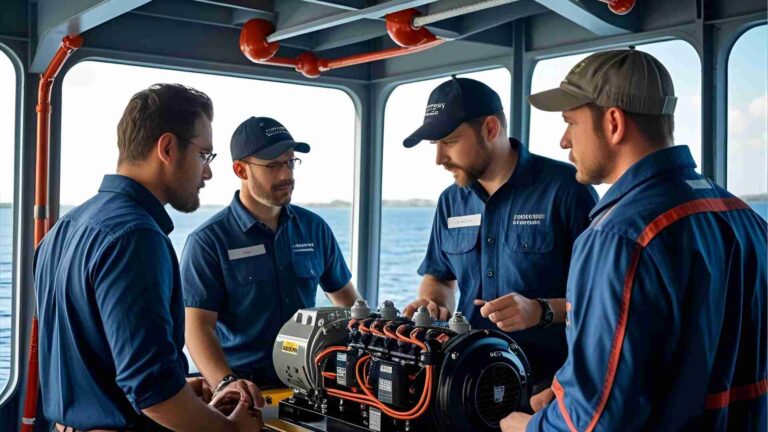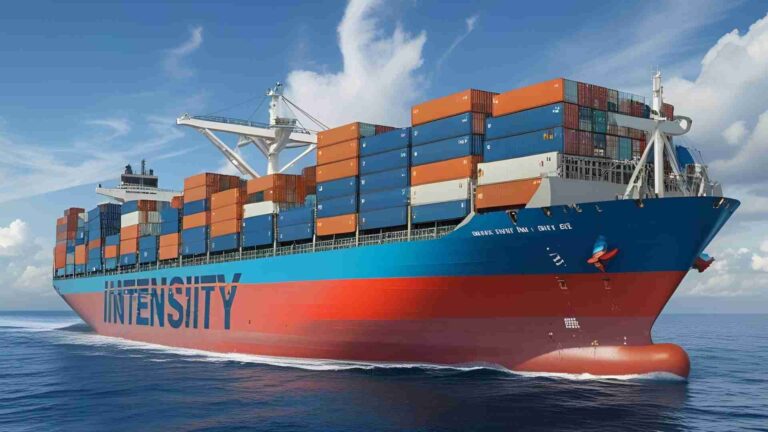Fire in the Engine Room: A Guide for Ship Engine Cadets and Students
The engine room serves as the core of a ship’s propulsion and operational systems, containing the main engine, generators, boilers, and auxiliary machinery. This space is vital for navigation, power generation, and overall vessel efficiency. However, it is also highly susceptible to fires due to the abundance of flammable fuels, lubricants, electrical components, and high-temperature surfaces.
For cadets and students in marine engineering, mastering fire prevention, detection, response, and recovery is essential to safeguard the crew, vessel, and environment. Fires in this area can lead to blackouts, propulsion failure, and risks like collisions or groundings. This comprehensive guide synthesizes key strategies, common causes, recovery protocols, and safety management practices to equip aspiring engineers with practical knowledge.
Understanding Engine Room Fire Risks
Engine rooms concentrate the three elements of the fire triangle: fuel (oils and gases), oxygen (from ventilation), and ignition sources (hot surfaces exceeding 400°C). Data from marine insurers indicates that nearly 60% of all ship fires originate here, with two-thirds involving main or auxiliary engines and components like turbochargers. The majority stem from failures in flammable oil systems, particularly low-pressure fuel piping, where leaks spray onto unprotected hot spots.
Common ignition points include exhaust manifolds, turbochargers, boilers, purifier heaters, and electrical switchboards. Temperatures in these areas often surpass oil auto-ignition points (around 250-400°C). Vessel age exacerbates risks; older ships show higher fire frequencies due to degraded insulation, inconsistent maintenance from ownership changes, and outdated detection systems. For instance, vessels over 20 years old have fire rates up to twice those of newer ones.
Passenger ships, car carriers, and container vessels exhibit higher fire frequencies, likely due to more auxiliary engines. Bulk carriers perform better in this regard. Mid-size vehicle carriers (10,000-20,000 DWT) and intermediate container ships (6,000-8,000 TEU) top main engine fire rates, while feeder containers (<3,000 TEU) lead in auxiliary fires.
Poor maintenance correlates with incidents; ships with over seven deficiencies per port state inspection face elevated risks, signaling broader issues in safety culture.
To illustrate fire origins, consider this table of incident distribution based on insurer data:
| Fire Location | Percentage of Total Ship Fires |
|---|---|
| Engine Room | 60% |
| – Main/Auxiliary Engines | 66% of Engine Room Fires |
| Cargo Areas | 15% |
| Accommodation | 10% |
| Other | 15% |
This underscores the engine room’s vulnerability, demanding rigorous protocols.
Prevention: The First Line of Defense
Prevention eliminates hazards before they ignite. Engine room fires often arise from three primary situations: flammable oil leaks onto hot surfaces, electrical failures, and mechanical breakdowns. Addressing these through maintenance and design mitigations is crucial.
Mitigating Oil Leaks on Hot Surfaces
Oil leaks from piping are the leading cause, often due to non-original parts, loose connections, or fatigue fractures. SOLAS regulations require insulating hot surfaces with non-absorbent materials, covered by sheet metal in a “roof tile” overlap to direct leaks to safe drains. Regular inspections using infrared thermometers or thermal cameras identify insulation gaps, especially after repairs.
Screen oil piping connections and restore screens post-maintenance. Flexible hoses must avoid stress, heat, or wear to extend lifespan. Implement engine manufacturer design improvements to prevent filter covers loosening or hose ruptures.
Hot surfaces like exhaust manifolds (over 500°C) must be shielded. Insulation quality varies by shipyard and degrades over time or from oil soaking. Use anti-splashing tapes and spray shields on high- and low-pressure lines. If shields are absent in original designs, retrofit them near leak-prone areas.
A case study illustrates risks: A copper fuel pressure gauge pipe (non-original, thinner wall) fractured on an auxiliary engine. Without a spray shield, fuel sprayed onto a 400°C turbocharger, igniting and damaging engines and cables. The vessel was offline for 40 days. Proper parts, shield reinstallation, and insulation would have prevented this.
Preventing Electrical Fires
Electrical fires start in switchboards, motors, or generators from dirt causing overheating/short-circuits or loose connections sparking arcs. Conduct planned maintenance: tighten terminals to specified torque, clean switchboards regularly. Melting cables can transmit heat, amplifying fires.
Avoiding Mechanical Failures
Mechanical issues like crankcase explosions from poor lubrication or ejected hot parts are rare but severe. Ensure timely engine maintenance and oil management.
General cleanliness reduces fuel availability: remove oily rags, cardboard, soaked insulation, and dirty bilges. These exacerbate fires by providing secondary fuel.
Fuel availability extends beyond leaks to stored combustibles. Oxygen supply depends on ventilation; quick closure of dampers limits fire growth. Response delays turn small incidents into major ones; empower crew for immediate action without awaiting orders.
Routine practices include:
- Inspect machinery for overheating/friction.
- Check fuel/oil lines for leaks, seals.
- Maintain clear, clutter-free spaces.
Older vessels need extra scrutiny: budget cuts, part shortages lead to temporary fixes increasing risks.
Incorporating thermal imaging enhances prevention. Marine thermal cameras like the FLIR M232 offer 320×240 resolution, 9Hz refresh, 4x zoom, priced around $2,500-$3,500. They detect hotspots during operations, surpassing spot thermometers. Classification societies offer notations requiring such tools.
Built-in features like steel separations limit spread; maintain integrity during alterations. Control ventilation: ensure fire flaps function, know all inlets. Adhere to oil system regulations, prevent tampering with valves.
Early Detection Strategies
Despite prevention, fires can occur. Early detection contains them. Use smoke detectors, alarms—test functionality, know response actions. Conduct fire patrols to spot hazards like unusual smells or smoke.
Thermal imaging identifies hotspots pre-ignition. Tools like the SIONYX Nightwave (CMOS sensor for low-light, marine-rated, approx. $1,500-$2,000) or FLIR models enable proactive scans.
Detection ties to crew awareness; regular checks during watches catch anomalies.
Combating Engine Room Fires Effectively
Upon detection, swift response minimizes damage. Know firefighting equipment locations and usage: CO2 systems, foam extinguishers, fire blankets.
CO2 systems flood spaces, displacing oxygen. Specifications: 70L cylinder, 70kg gas, 5.7MPa working pressure, 12.4MPa max, discharge ≤60s, DC24V/1.6A power. Average cost for small systems: $1,200-$1,750. Marine-approved, with pre-alarm and delay for evacuation.
Foam extinguishers smother Class A/B fires. Examples: 2kg portable, $30-$75; 2.5gal AFFF, $397; 50L wheeled, with 5m hose, 1.2MPa pressure. Effective range 9m, 12-year life.
Follow protocols: isolate fuel/ventilation, cut power. Use muster lists, coordinate via drills. Empower initiative to avoid delays.
Fixed systems like CO2 or foam must be operational; recharge post-use.
For response, follow this flowchart:

This structured approach ensures coordinated action.
Aftermath: Assessment and Recovery
Post-extinguishment, confirm fire out using thermal cameras to check hotspots. Wear PPE (breathing apparatus, fire-resistant clothing) for entry.
Ventilate carefully to remove smoke/toxics, avoiding spread to accommodation.
Assess damage: visual inspection of machinery, electrics, pipes, tanks, structures. Check bulkheads, decks for integrity. Evaluate propulsion; consult home office/insurers for continuation or towage.
Contain spills to prevent environmental harm. Remove debris, decontaminate surfaces from chlorides, soot, oil.
Restore systems: inspect/repair electrics, machinery, fire suppression. Test all, conduct trials.
Prepare repair specs, incident reports with crew statements. Notify insurers (H&M, P&I), authorities.
Investigate root cause (e.g., leak, fault), implement preventives fleet-wide: update maintenance, procedures, training.
Support crew: medical checks for inhalation, counseling for trauma.
Review drills, integrate lessons into SMS.
Recovery costs are high; every minute post-fire can add $200,000 in repairs, excluding downtime.
Training and Awareness for Ongoing Safety
Fire safety requires continuous effort. Participate in firefighting courses for latest techniques/equipment. Share incident lessons to enhance team response.
Drills reinforce protocols, build confidence. Foster safety culture emphasizing prevention, maintenance.
Implementing a Safety Management System (SMS)
An SMS provides structured procedures for safe operations. It minimizes risks like blocked escapes, waste buildup, slippery decks, jammed doors, height hazards.
Include in SMS:
- PPE requirements: anti-slip shoes, helmets, gloves, eyewear, coveralls.
- Emergency roles/responsibilities.
- Safe loads for lifts/machinery.
- Accident documentation.
- Electric/circuit capacities.
- Communication workflows.
- Environmental policies per flag state.
- Vessel details: storage, maintenance.
Distribute copies, train all crew.
Additional practices:
Oil Disposal Protocols
Dispose contaminants properly to avoid fires, pollution, health issues. Use retention tanks for sewage/liquids, grease traps. Discharge treated bilge only; store solids/sludge for land disposal. Incinerate oil waste in dedicated tanks after OWS filtering.
Designate containers for oily rags; recycle filters; store flammables securely.
Bilge Management
OWS separates oil from water; maintain coils, seals, piping. Paint bilges bright for leak spotting; use drip trays. Separate chemicals to avoid pH imbalances.
Clean with air-powered washers, compatible cleaners. Avoid washing electrics, sensors, gaskets.
Fire Precautions
Institute oil disposal policy: incineration, containers. Diagnose leaks via pressure/tightness tests (1.5x design pressure). Monitor sensors; note fuel types (ultra-low-sulfur more leak-prone).
Maintain pipes: lag steam/fuel/exhaust; inspect supports, insulation; test water systems; avoid compression joints on flammable lines; minimize joints at intersections.
Data Insights on Fire Frequencies
Annual main engine fire frequency: 0.07% (7 per 10,000 vessels); auxiliary: 0.04%. Trends show slight decline for main, steady for auxiliary.
Higher in passenger/container/car carriers due to engine count.
Age impact: Fires rise with age, aligning with PSC detention rates.
Deficiencies correlate: >7 per inspection doubles risk.
Engine Room Fire Frequencies by Vessel Age

This pie chart approximates risk escalation.
Recommendations for Risk Mitigation
- Identify leak sources: Integrate checks for fittings, hoses into PMS. Verify original parts, especially on second-hand vessels.
- Map hotspots with thermography: Use onboard cameras periodically; include in newbuild specs. MAIB recommends IMO mandate this.
- Shield hotspots: Check insulation for degradation/oil soak; refit spray shields post-maintenance.
External audits provide independent hazard assessments.
By integrating these, cadets can contribute to safer engine rooms, reducing incidents and consequences.
Frequently Asked Questions
Engine room fires are primarily caused by flammable oil leaks onto hot surfaces (e.g., exhaust manifolds, turbochargers), electrical failures in switchboards or motors due to dirt or loose connections, and mechanical failures like crankcase explosions.
Over 60% of ship fires originate in the engine room, with two-thirds linked to main or auxiliary engines, often due to fuel piping failures.
Prevention involves regular maintenance to avoid overheating, inspecting fuel/oil lines for leaks, and maintaining cleanliness to remove combustible materials like oily rags. Insulate hot surfaces with non-absorbent materials, use spray shields, and conduct thermal imaging to detect hotspots. Adhering to SOLAS regulations and ensuring original parts in piping systems are critical.
Key equipment includes CO2 systems (70L cylinders, $1,200-$1,750), foam extinguishers (2kg portable, $30-$75; 2.5gal AFFF, $397), and fire blankets. Crew must know their locations and usage. Fixed systems should be recharged post-use, and emergency water nozzles must be functional for containment.
Training ensures crew can respond swiftly and correctly, minimizing fire spread. Regular drills reinforce protocols, such as isolating fuel/ventilation or using extinguishers. Empowering crew to act without delay and sharing lessons from incidents enhance response effectiveness. A strong safety culture reduces risks.
Confirm the fire is out using thermal cameras, wear PPE for entry, and ventilate to remove smoke. Assess damage to machinery, electrics, and structure; contain spills; and decontaminate surfaces. Restore systems, conduct trials, and report to insurers/authorities. Investigate root causes and update procedures to prevent recurrence.
An SMS outlines procedures for maintenance, waste disposal, PPE use, and emergency protocols, ensuring clean, safe engine rooms and reducing fire risks from oil leaks, electrical faults, and clutter through training and compliance.
Conclusion
Engine room fires pose a significant threat to ship safety, demanding rigorous prevention, detection, and response strategies from marine engineering cadets and students. By prioritizing routine maintenance, such as inspecting fuel lines and insulating hot surfaces, and leveraging tools like thermal imaging, risks from flammable oils, electrical faults, and mechanical failures can be minimized.
Early detection through smoke alarms and patrols, coupled with proficient use of CO2 systems, foam extinguishers, and emergency protocols, ensures swift containment. Post-fire recovery involves thorough damage assessment, system restoration, and root cause analysis to prevent recurrence.
Continuous training and a robust Safety Management System foster a proactive safety culture, empowering crews to act decisively. For aspiring engineers, mastering these practices is critical to safeguarding vessels, crew, and the environment. By integrating prevention, preparedness, and recovery, cadets can contribute to safer maritime operations, ensuring engine rooms remain the reliable heart of a ship rather than a source of catastrophe.
Happy Boating!
Share Engineering Department Role in Ensuring the Vessel’s Safety and Efficient Handling with your friends and leave a comment below with your thoughts.
Read MARPOL Annex IV: Ship Aero Sewage Treatment Plant (STP) until we meet in the next article.






